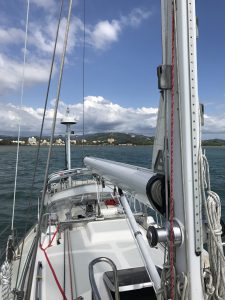Voyage to Puerto Rico, Part 1
Anchored in Mayaguez Bay, Puerto Rico
We arrived on the East Coast of Puerto Rico yesterday afternoon! This was our longest and most difficult trip yet. We were both pretty tired after the journey that spanned four days and awoke after 14 hours of deep sleep to a beautiful, calm morning in the Bay of Mayaguez. Here is the story:
Back at the Turks and Caicos (TCI) we had been monitoring the weather forecast for an acceptable window to get to Puerto Rico (PR). The passage from TCI to PR is kind of tricky: It’s a fairly long route, over 400 statute miles. And the direction of travel is mainly east, against the easterly trade winds which can be quite strong. To review: If the wind is coming directly from your direction of travel, it is impossible to sail and very difficult to motor only, you move very slowly into waves that rock you around quite a bit. It’s not really practical for us to motor that distance in those conditions.
The trick is to wait for better wind conditions that do happen but are out of the norm. And since the trip takes several days, it’s less likely you’ll get favorable conditions for the entire passage. Plus, the weather forecast gets more shaky the further out you go. SO, you have to take a bit of a gamble when you commit.
If you look on a map you see the Dominican Republic lies along the route from TCI to PR. Lots of sailors stop there. That strategy has a few caveats though: You have to clear into the country which costs a few hundred dollars. Also, if you want any services, everyone expects a “tip.” Apparently this includes the official immigration people as well. An experienced friend told Shelly to “…offer them a shot and $20” to expedite the bureaucracy. Some may call this a “bribe,” but there it is called a “tip.”
The other problem is that all the stopover anchorages in the Dominican Republic are essentially just delaying the inevitable passage east. If conditions get too bad, these places are a good option to wait it out for the next window, but that may take a week or more to get that weather. If it takes two weeks, you may need to get to a marina to resupply, but guess what? Most of the water is undrinkable so you can’t put it in your boat water tanks without contaminating them. So for us, stopping there would kind of be a last resort as a haven if the weather deteriorated badly.
The best plan was to try to get to PR in one long sail. It would be about twice as long as anything we’d done to date. Adding to the fun, this passage was described as “…the most difficult passage to the Caribbean” that you could do. Much of the difficulty comes from the section known as the Mona Passage, which is the relatively narrow channel between the Dominican Republic and Puerto Rico. It is notorious for rough conditions and there are sections you want to avoid altogether. The conditions are caused by the Atlantic and Caribbean tidal currents running through extremely deep water before being forced up into relatively shallow water in the channel. Add wind to that and you can get some bad wave conditions, including large whirlpools. Giant commercial ships avoid these sections because they can be so bad. The other thing you have to look forward to is crossing at night. At the end of your trip. Yea baby!
So we waited for ourat the excellent TCIs for our window. A large low pressure system that threatened to become a tropical depression spun for many days just north of us. It just sat in one place and spun and spun. It caused the rain I described in my previous post here. This low pressure system was not really causing us bad weather any more but was generating huge waves that made it impossible to get out of the bay we were in. So we waited.
Finally we saw our opportunity. The window we were waiting for had materialized but the waves were still pretty big. We changed our planned route to go around the west side of the TCI bank instead of heading straight east. That way we would have only a couple hours of big waves while the bank would protect us for an entire day of sailing, at which time the waves would calm down a lot.
It took several hours to get going because we had to fuel up and wait for the TCI immigration people to come to the marina and “check us out.” In an airport, you go to them by waiting in a long line usually. On a boat they come to you, which is kind of cool.
We got going at 2 pm. We wove our way through the tricky shallow area behind the reef on the north side of Providenciales and exited through Sellar’s Cut. It was pretty wild with big breaking waves on either side of us as we went out.
More in part 2.
Posted in Sailing by Mark with comments disabled.
